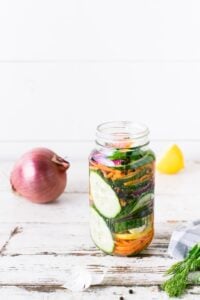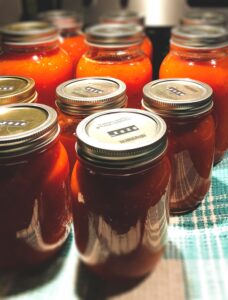Canning 101

Water bath canning – This is the most common canning method used to prepare canned foods. It uses a large pot filled halfway with water and a rack inside the pot to hold jars off the bottom of the pot. Water bath canners are used for high acid foods such as fruits, jams and jellies, pickles and salsa., which have a pH below 4.6. The boiling water temperatures in water bath canners ensure that botulism spores and other bacteria that may be present in low acid foods don’t survive and multiply to dangerous levels.
Water bath canning is easy if your jars are pre-sterilized and you have prepared your recipe according to the proper steps.
Preserving food yourself not only saves money but it gives you the ability to choose exactly what goes into your food. No more worrying about what was left on the conveyor belt at the grocery store or wondering if the tomatoes were picked ripe or green.
The first time I tried to can tomatoes I was so frustrated that I almost gave up. It wasn’t for lack of trying. I had tried every recipe out there and even tried to use other people’s recipes with little success.
That’s why I started this blog: to help you preserve foods and keep the money in your pocket. I want to show you how to can so you will feel confident in your ability to meal prep and save money by growing and preserving your own food!
Yep, that’s right—I want to help you learn how to can because it’s the most fun thing in the world.
Why? Because it saves money and it’s simple to do! It makes fruits and vegetables available at any time of the year. It allows you to give homemade gifts that people actually appreciate. And did I mention, IT SAVES MONEY!!!
Let’s start with the basics:
What is canning?
Simply put, canning is a method of food preservation which involves heating food to kill any microorganism that could be harmful to your health. There are two methods of safe canning: water bath canning and pressure canning. Both of these methods are used to preserve different types of foods.
Canned food is really great for storing food long term. It can be stored in a cool, dry place for up to 10 years or more. You can also can your own foods at home, which is much cheaper then buying canned food at the store. This way you know exactly whats in your food and where it comes from. It also makes a great barter item if there ever was one!
The two types of canning in more detail:
Pressure canning for food preservation is a process where the goal is to keep the temperature above 240 degrees Fahrenheit, which is the temperature at which the food will begin to break down. The main purpose of pressure canning is to destroy microorganisms that cause spoilage and food poisoning.
Pressure canning also keeps your food from becoming too soft or mushy once you open it. If you’re planning on putting up high-acid foods, like tomatoes, juices, fruits, pickles, salsas and tomato sauce, pressure canning is an ideal method of preservation.
Pressure canners are also used for low-acid foods, but the process has to be regulated with a pressure regulator to make sure that the heat doesn’t get too hot. This type of canning requires more attention because you won’t have the safety factor of knowing if your cans are properly sealed until after you’ve opened them.
Water bath canning is the most basic method of food preservation. It is most commonly used for high acid foods like fruits, pickles and jams.
The principle behind water bath canning is basically simple. The food inside jars is placed in boiling water to preserve the contents. The process is controlled simply with boiling water. Once the water is boiling, allow jars to be canned at a certain amount of time. No pressure required.
A wide variety of foods including vegetables, meats, eggs, milk and fruits are preserved through water bath canning. Tomatoes are one of the most popular items to preserve through this process. Another common type of food preserved through this method is jellies and jams.
The following are some tips for using this method:
Be sure you use clean jars that haven’t been used before in the water bath canner. If they have, be sure to wash them in soapy, hot water and rinse thoroughly before using them again.
Equipment you may find useful or necessary:
- Canner with Lid for Water Bath
- Jar Lifter
- Jar Funnel
- Bubble remover/Headspace Tool
- Cooking Timer
- Get the Complete Kit with everything in it here
- Ball Jars
- Ball 2-Piece Lids
- Labels for Canning Jars

Here’s a short list of foods that are safe for canning using water bath:
HIGH ACID FOODS such as
- Fruit
- Fruit Jams & Jellies
- Tomatoes & Tomato Products
- Cucumber Pickles
These are just a few examples of the many!
MUST DO WHEN CANNING:
- Lining up ingredients for canning. So everything is easily accessible in a quick moment, canning can go very quickly.
- With so many recipes available, it can be hard to choose just one. But once you have found the perfect recipe, follow it to a tee.
- Filling jars according to head space is a common issue for those new to canning. It’s not rocket science, but it does require some practice.
When you fill your jars, leave the proper amount of head space as specified in your recipe. Head space is the amount of space between the product and the top of the lid. You’ll see the amount of head space you need to leave in your recipe. Also, swipe around the jar and release air bubbles that can accumulate.
As a general rule, you want a minimum of 1/4-inch head space for jams and jellies and 1/2-inch head space for fruits and vegetables or liquids. - Cleaning your jar lids can help ensure that your jars will seal properly after you fill them with food. If the rims are not clean, the lids may not seal completely which could cause your foods to spoil.
- I recommend you check the altitude of where you live.
If you live at an altitude below 1,000 feet (305 meters), you can use the standard processing times outlined in your recipe.
If you live between 1,000 and 3,000 feet (305 to 915 meters) above sea level, increase your processing time by 5 minutes.
If you live between 3,000 and 6,000 feet (915 to 1,830 meters) above sea level, increase your processing time by 10 minutes.
If you live above 6,000 feet (1,830 meters), see below for additional information on safely canning at higher altitudes.
1,001 to 3000 ft –> Add 5 minutes
3,001 to 6000 ft –> Add 10 minutes
6,001 to 8,000 ft –> Add 15 minutes
8,001 to 10,000 ft –> Add 20 minutes - After the timer goes off, use a jar lifter to lift each jar from canner and place on a towel or cooling rack. Let jars cool until you hear a popping noise, which indicates the vacuum seal has been formed. The lids should be sucked down by now. If they still seem loose, just wait for an hour or so longer because sometimes it takes a while.



